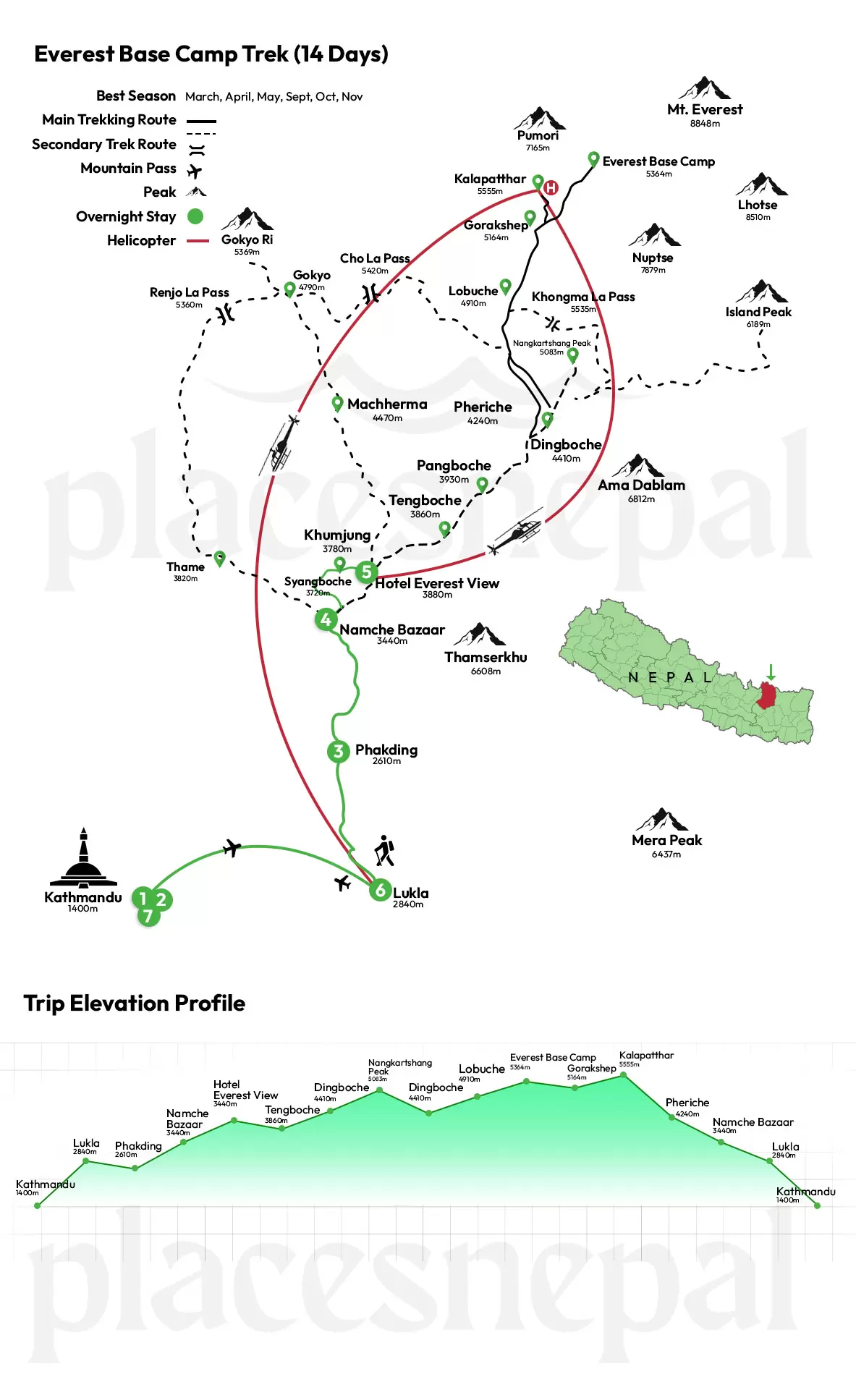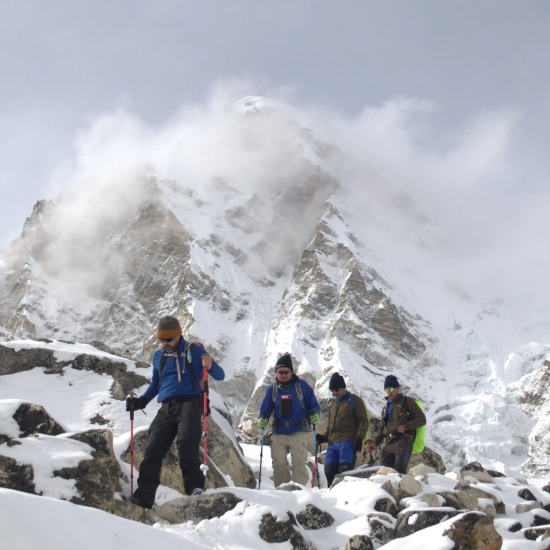Experience the Everest Base Camp Trek in unparalleled luxury. This isn't your typical trekking adventure; indulge in the finest accommodations, from world-class hotels in Kathmandu like the Hyatt Regency and the Kathmandu Marriott to the exclusive Yeti Mountain Home in Kongde. Savor gourmet meals prepared by expert chefs and benefit from the guidance of experienced Sherpas as you explore the awe-inspiring landscapes of the Everest region.
This extraordinary journey begins with a scenic helicopter flight from Kathmandu (1,350m) to Lukla (2,860m), the gateway to the Everest region. From Lukla, get started on a short hike to Phakding (2,652m), enjoying the picturesque scenery and staying overnight at the Yeti Mountain Home, a luxurious lodge.
The next day, trek along the Dudh Koshi River, immersing yourself in the serene beauty of the pine forests. Reach Namche Bazaar (3,440m), the vibrant Sherpa capital, known for its bustling market and stunning mountain views. Experience the charm of this high-altitude town while staying at a luxurious lodge.
Continue your journey towards the iconic Everest View Hotel (3,880m), the highest luxury hotel in the world. Enjoy breathtaking panoramic views of Mount Everest (8,848m), Lhotse (8,516m), and Ama Dablam (6,812m) from the comfort of your room.
The highlight of this trek is an exclusive private helicopter tour, taking you to Kala Patthar (5,545m) and Everest Base Camp (5,364m). Witness the awe-inspiring majesty of Mount Everest and the surrounding Himalayan peaks, including Pumori (7,165m), and Nuptse (7,861m). Enjoy breathtaking aerial views of the Gokyo Valley and picturesque Sherpa villages before landing at Kongde for a luxurious lunch at the exclusive Yeti Mountain Home.
After lunch, fly back to the serene Kavya Himalayas Resort in Nagarkot (2,175m), offering stunning views of the Himalayas, including Manaslu (8,163m), Ganesh Himal (7,406m), and the Annapurna range.
The next day, enjoy a delicious breakfast at the resort, followed by a visit to charming rural Nepali villages in the lower hills. Drive to Kathmandu, stopping at the UNESCO World Heritage Site of Bhaktapur Durbar Square for a cultural immersion. Indulge in a delicious Newari cuisine in Bhaktapur before arriving in Kathmandu and enjoying a final night at the luxurious Hyatt Regency.
This 8-day Everest Base Camp Luxury Trek offers a unique blend of adventure, luxury, and cultural immersion. Experience the majesty of the Himalayas in unparalleled comfort and create memories that will last a lifetime.
Itinerary Overview
Day 1: Arrive to Kathmandu (1350m / 4430 Ft)
Places Nepal’s representative will receive you at the Tribhuvan International Airport. After a warm welcome, you will be transferred to the 5-Star Category Hotel in Kathmandu.
After checking in, you will be taken to Thamel, Kathmandu's vibrant tourist district, to explore its lively atmosphere. In the evening you will have a welcome dinner with the Places Nepal Guest Manager who will give you a brief orientation about the trek.
After dinner, you will be spending the evening relaxing and preparing for the upcoming adventure.
Day 2: Kathmandu UNESCO Heritage Tour (1350m/4430ft)
Today marks a special day in our Kathmandu journey. After breakfast, we go on a guided tour of the city's UNESCO World Heritage Sites, including the iconic Kathmandu Durbar Square, Swyambhunath Temple, Pashupatinath Temple, Bouddhanath, and Patan Durbar Square. This exploration will immerse us in Nepal's rich history, culture, and religion. Along the way, there's also the opportunity to shop for trekking gear and souvenirs.
Later, we'll visit the Places Nepal office to meet our trekking guide and receive a detailed briefing about our upcoming trek. The day concludes with a restful night at our hotel, as we anticipate the adventures ahead.
Day 3: Fly to Lukla (2840m/9318ft/ 35minute flight) and Trek to Phakding (2610m/8563ft)
Today, after breakfast you'll start your journey toward the airport for a scenic helicopter flight to Lukla from Kathmandu. You will witness the awe-inspiring Himalayan panorama from a thrilling helicopter ride.
From Lukla, you will trek with a downhill walk to the iconic suspension bridge at Phakding. From there, you'll hike on a challenging uphill hike to Monjo, the gateway to Sagarmatha National Park.
Continuing your journey, you'll trek through Jorsale, crossing the Dudh Koshi River on a suspension bridge. Finally, you'll reach Namche Bazaar, the Sherpa capital, where you can admire the breathtaking views of the surrounding peaks.
After a day of trekking, you'll rest and recharge at your teahouse in Namche Bazaar, enjoying a well-deserved break.
Day 4: Trek from Phakding to Namche Bazaar (3446m/11306ft)
You will start your hike to Namche Bazaar after Breakfast. The trail follows the path alongside the Dudh Koshi River and winds through dense pine forests entering the Sagarmatha National Park. As we continue, the trail ascends with a series of twists, rewarding us with our first breathtaking views of the towering peaks of Mt. Everest, Thamserku, and Kongde.
Nestled within the Khumbu region, Namche Bazaar, often considered the historical capital of the area, serves as a prime spot for trekkers to acclimatize. Namche Bazaar offers panoramic vistas of Kongde Ri in the foreground, Khumbila to the rear, and the dramatic peaks of Kangtega, Thamserku, and Kusum Khangkuru to the east.
Along the way, we pause for lunch at the Bishal Resturant in Jorselle. Later, we spend the night at the cozy Yeti Mountain Home (YMH) in Namche. Here, we can savor a delicious dinner and retreat to a warm and comfortable bedroom for a restful sleep.
Day 5: Trek to Everest View Hotel (3880m / 12730ft)
After an exhilarating hike of about 2 hours, you'll arrive at the Everest View Hotel, a luxurious sanctuary nestled in the heart of the Khumbu region. The hike to the hotel is challenging, with a steep ascent that takes approximately two hours. However, the effort is amply rewarded by sweeping vistas of the surrounding mountains, including unparalleled views of Everest itself.
Once you reach the hotel, you’ll be greeted warmly by the staff and offered a refreshing welcome drink. The hotel's serene atmosphere invites you to relax and unwind while taking in the breathtaking scenery from the comfort of the restaurant. It’s the perfect place to bask in tranquility and enjoy the magnificent views of the Himalayas.
The Everest View Hotel is designed with your comfort in mind, featuring rooms equipped with cozy amenities such as a dressing area, electric blankets, heater, thermos, and complimentary Wi-Fi. Whether you’re looking for rest or a quiet place to recharge, the hotel provides a peaceful retreat.
The hotel's reputation for outstanding cuisine makes dining here a memorable experience. You'll savor delicious meals with your trekking companions in a cozy, inviting atmosphere. After a day of adventure, spend the night in the comfort of the hotel, enjoying the warmth and relaxation of the world's most luxurious Hotel.
Day 6: Helicopter Tour to Everest Base Camp - Fly over Gokyo - Land in Kongde and fly to Lukla and from Lukla fly to Nagarkot
Today promises to be an unforgettable adventure with a private helicopter tour of the iconic Everest region. After breakfast, you'll lift off from the Hotel Everest View, soaring above the majestic landscapes and catching breathtaking views of Mount Everest, the tallest peak in the world.
Your journey takes you over Everest Base Camp and onward to Kalapatthar, where you'll be treated to sweeping panoramic views of the stunning Himalayan range. Next, glide towards the tranquil Gokyo Lakes, their turquoise waters shimmering amidst the snow-covered peaks.
To top off this extraordinary experience, enjoy a celebratory lunch at the Yeti Mountain Home in Kongde, surrounded by unparalleled mountain vistas.
As your tour winds down, you'll return to Lukla before heading to the luxurious Kavya Himalayas Resort in Nagarkot. Unwind in the comfort of your cozy room, reliving the incredible moments of your Himalayan adventure.
Day 7: Nagarkot To Kathmandu via Bhaktapur Durbar Square
Start your day with a delightful breakfast at the Kavya Himalayas Resort, fueling up for the journey ahead. After breakfast, set off on a scenic two-hour drive back to Kathmandu.
On the way, stop to explore the enchanting Bhaktapur Durbar Square, a UNESCO World Heritage Site. Step into the heart of this medieval city, where history comes alive through its stunning architecture. Marvel at iconic landmarks like the Nyatapola Temple, the 55-Window Palace, the Golden Gate, and the Dattatreya Temple as you soak in the rich cultural heritage.
After your visit, head back to the Kathmandu Marriott Hotel to unwind. In the evening, treat yourself to a special dinner in Thamel. If you're in the mood for some nightlife, you can opt to visit an international club, or simply enjoy a relaxing night in the comfort of your hotel room.
Day 8: Final Departure
We’ll take care of all the details for your transport to Tribhuvan International Airport on your departure day. Our team will assist you with your luggage and guide you through the check-out process. As your private vehicle navigates through Kathmandu’s lively streets, take a moment to soak in the vibrant charm of the city one last time. At the airport, our staff will see you off with warm wishes for a safe and pleasant journey ahead.
Let us know if you’re considering staying longer to explore more of Nepal’s wonders. We’d be thrilled to plan another unforgettable adventure tailored just for you!



-webp.webp) Trek Permit Required
Trek Permit Required 


















































